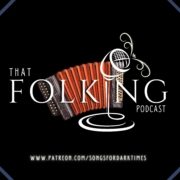What’s In A Name?
Discussing issues of racism, sexism, and censorship in folk song.
A few weeks ago, I posted a question on one of my social media platforms:
“Folk Music Friends…
Say you have a piece in your repertoire which, perhaps, you later discover has lyrics that could potentially be deeply offensive to a particular group or themes you do not wish to support, but you still believe the piece has intrinsic value. What do you do?
A. Never perform it again!
B. Use it to educate my audience.
C. Discuss with said group(s) & gather outside opinions.
D. Art is art & history should not be censored!”
As I suspected, most of the responses I received were very similar to my own, choosing a combination of B and C, along with the suggestion that lyrics could and should be altered to avoid the unpleasant or offensive content, when possible (the last being an option I had purposefully left out, for reasons I will explain later). The initial post was provoked by an unexpected debate I witnessed (and lightly involved myself in) regarding a piece in my own repertoire.
The song in question is a well-known piece from the Irish repertoire, known as The Tinkerman’s Daughter (sometimes also called The Redheaded Anne). Despite what most of my audience members believe, this is not a very old song. In fact, the man who wrote it—Mr. Mickey MacConnell—is still alive and well (or was when I wrote to him a few years back). However, it has become an undeniable part of the living Irish tradition, and has since been covered by a slew of well-known folk artists.
There are many reasons why I, personally, choose to sing this song. It is a piece which has allowed me to discuss a number of issues that are close to my heart, when performing it live, including women’s autonomy, the price of racism and blind hatred which inevitably leads to violence, the differences between love and possession, and the linguistic history associated with the term ‘Gypsy.’ It also happens to be the most requested song in my repertoire. And yet, I have begun to wonder in recent years whether or not I truly have a right to sing it. Before we get into that, let us too touch on said history of the term ‘Gypsy,’ as well as that of a few other terms…
— GYPSY, TINKER, TRAVELLER —
Now, I want to make it clear that I am not a linguist, etymologist, cultural anthropologist. Neither am I an expert on the people who call themselves Romani/Romany (nor any other nomadic peoples, for that matter). I am merely a folksinger and traveler, with a deep interest in and respect for the expansive subject that is Romani culture and history. Likewise, I want to mention that this article is not meant to be an in-depth look at the history or culture of the Romani peoples, though I do hope to have a discussion on this subject at a later date, preferably lead by a member of the Romani community.
If you come from the US, as I do, you might be hard-pressed to recognize the terms ‘Roma’ or ‘Romani,’ but you are very likely familiar with the term ‘Gypsy,’ so let’s begin there. Most historians believe that ancestors of the Roma community came to Europe from northern India—traveling through what is now Iran, Armenia, and Turkey—and gradually spreading across the European continent, from the 9th century onwards. The term ‘gypsy’ is an exonym (a name imposed upon geographic region or ethnic group by outsiders), stemming from the term ‘gipcyan,’ a colloquial shortening of the word ‘Egytian,’ due to a common misconception that these nomadic peoples had migrated from Egypt. At least, that is the common theory. The word Gypsy, in Western American culture, is thrown around frequently, having become synonymous with being ‘free-spirited,’ one who longs to travel, and associated with a certain style of ‘bohemian’ dress and lifestyle (bohemian being linked to other misconceptions of the origins of the Roma). America, while further removed from the dark and brutal history and hardships surrounding actual ‘gypsy’ culture (or having romanticized it), however, is not alone in this. Like with many cultures that experience racial prejudice, large-scale social exclusion, discrimination and violence, certain aspects of the culture become glorified to the point of caricature (whether these elements of the culture are authentic or superimposed), and their traditions are frequently appropriated, even to the point of misattribution—such as with many of their music and dance traditions. However, even to this day there remains an even stronger, deep-seated hatred towards the Roma.
Another term whi
What’s In A Name?
Discussing issues of racism, sexism, and censorship in folk song.













